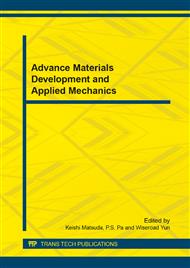[1]
Ghalia, S. Msahlia, M. Zidib, F. Saklia, Effect of pre-treatment of Luffa fibres on the structural properties, Materials Letters 63 (2009) 61–63.
DOI: 10.1016/j.matlet.2008.09.008
Google Scholar
[2]
Xu Yunhui, Chen Yuyue, Lin Hong, Research on progress and development trend of oxidized cellulose, Suzhou University Journal (Engineering Science Edition) 2006, 26-2.
Google Scholar
[3]
Alessandro Zampieria, Godwin T.P. Mabandea, Thangaraj Selvama, Wilhelm Schwiegera*, Alexander Rudolpha, Ralph Hermanna, Heino Sieberb, Peter Greilb, Biotemplating of Luffa cylindrica sponges to self-supporting hierarchical zeolite macrostructures for bio-inspired structured catalytic reactors, Materials Science and Engineering C 26 (2006).
DOI: 10.1016/j.msec.2005.08.036
Google Scholar
[4]
Mohd. Rafatullaha, Othman Sulaimana, Rokiah Hashima, Anees Ahmadb, Adsorption of methylene blue on low-cost adsorbents: A review. Journal of Hazardous Materials 177 (2010) 70–80.
Google Scholar
[5]
G. HENINIa*, Y. Laidania, F. Souathib, S. Haninc, Study of static adsorption system phenol/Luffa cylindrical fiber for industrial treatment of wastewater, Energy Procedia 18 ( 2012 ) 395 – 403.
DOI: 10.1016/j.egypro.2012.05.051
Google Scholar
[6]
V. K. Guptaa, S. Agarwala, P. Singha, D. Pathaniac, Acrylic acid grafted cellulosic Luffa cylindrical fiber for the removal of dye and metal ions, Carbohydrate Polymers 98 (2013) 1214– 1221.
DOI: 10.1016/j.carbpol.2013.07.019
Google Scholar
[7]
N. Akhtara, A. Saeedb, M. Iqbalb*, Chlorella sorokiniana immobilized on the biomatrix of vegetable sponge of Luffa cylindrica: a new system to remove cadmium from contaminated aqueous medium, Bioresource Technology 88 (2003) 163–165.
DOI: 10.1016/s0960-8524(02)00289-4
Google Scholar
[8]
Hao feng et al., The sorption of active red dye onto chitosan/cellulose hybrid particles, Adanced Materials Rearch, 115 (2011) 183-185.
DOI: 10.4028/www.scientific.net/amr.183-185.115
Google Scholar
[9]
Min-Yun Changa, Ruey-Shin Juangb, Equilibrium and kinetic studies on the adsorption of surfactant, organic acids and dyes from water onto natural biopolymers, Colloids and Surfaces A: Physicochem. Eng. Aspects 269 (2005) 35–46.
DOI: 10.1016/j.colsurfa.2005.06.064
Google Scholar
[10]
R.C. Bansal, M. Goyal, Activated Carbon Adsorption, CRC Press Taylor & Francis Group 6000, Suite 300 Boca Raton, FL, (2005).
DOI: 10.1021/ja059874h
Google Scholar
[11]
U.J. Rivera, P.M. Sanchez, Adsorption of Cr (III) on ozonised activated carbon, Importance of Cπ—cation interactions, J. Water Research, 37. 14 (2003) 3335~3340.
DOI: 10.1016/s0043-1354(03)00177-5
Google Scholar
[12]
L. Ghali, S. Msahli, M. Zidi, F. Sakli, Effect of pre-treatment of Luffa fibres on the structural properties, J. Materials Letters 63 (2009) 61–63.
DOI: 10.1016/j.matlet.2008.09.008
Google Scholar
[13]
H. Demir, A. Top, D. Balköse, S. ülkü., Dye adsorption behavior of Luffa cylindrica fiber , Journal of Hazardous Materials 153 (2008) 389–394.
DOI: 10.1016/j.jhazmat.2007.08.070
Google Scholar
[14]
C.L. Ye*, N. Hu, Z.K. Wang, Experimental investigation of Luffa cylindrica as a natural sorbent material for the removal of a cationic surfactant, Journal of the Taiwan Institute of Chemical Engineers 44 (2013) 74–80.
DOI: 10.1016/j.jtice.2012.08.006
Google Scholar
[15]
Y.S. Peat Ho and G. Mckay*, The kinetics of sorption of divalent metal ions onto sphagnum moss, Wat. Res. Vol. 34, No. 3 (2000) p.735±742.
DOI: 10.1016/s0043-1354(99)00232-8
Google Scholar
[16]
C.C. Leng, N.G. Pinto, J. Carbon, 35. 9 (1997) 1375~1385.
Google Scholar
[17]
C.O. Ania, J. B. Parra, Pis J. J., J. Fuel Processing Technology, 79. 3 (2002) 265-271.
Google Scholar
[18]
T. Garcia, R. Murillo, J. Cazorla Amoros D. Carbon, 42 (8-9) ( 2004) 1683-1689.
Google Scholar


